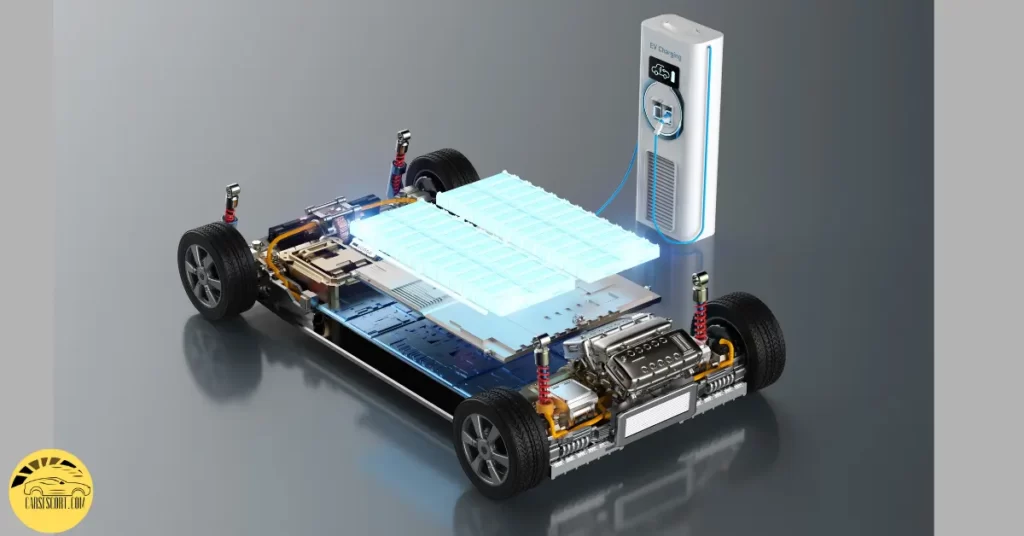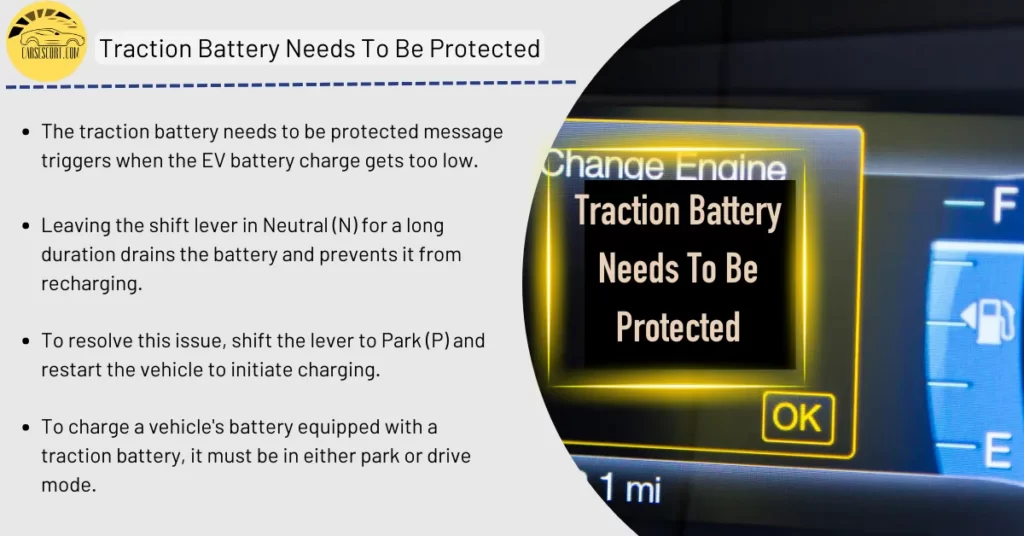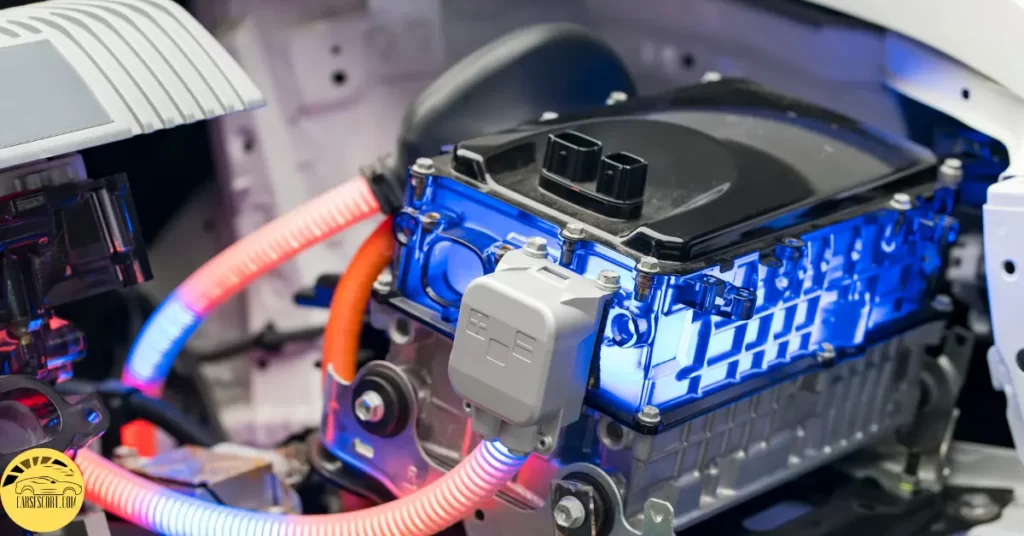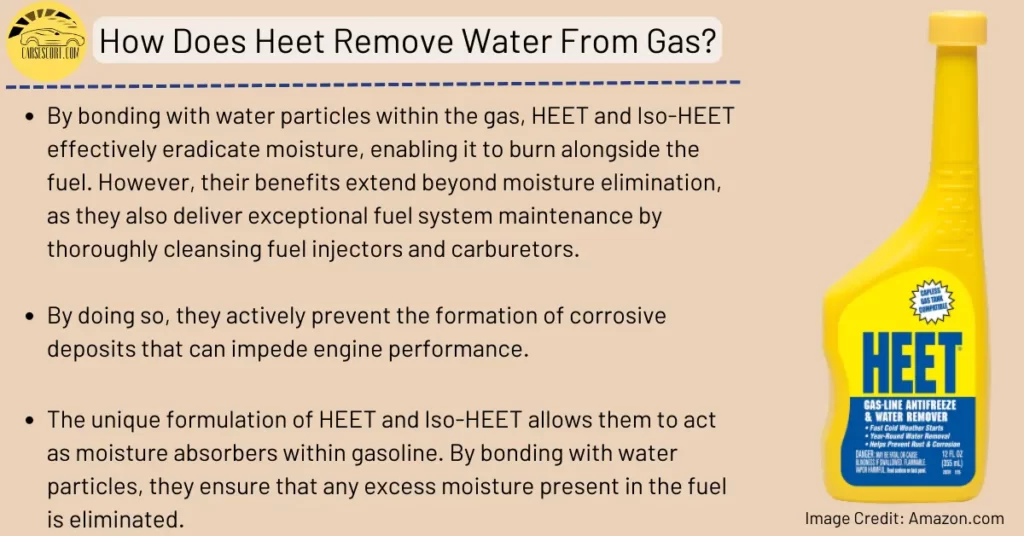As the automotive industry moves toward a greener and more sustainable future, electric vehicles (EVs) have gained significant popularity. The traction battery power Toyota’s eco-friendly vehicles. As the lifeblood of EVs, the traction battery is responsible for storing and supplying energy to propel the vehicle.
What does the Traction Battery Needs To Be Protected message mean?
- The traction battery needs to be protected message triggers when the EV battery charge gets too low.
- Leaving the shift lever in Neutral (N) for a long duration drains the battery and prevents it from recharging.
- To resolve this issue, shift the lever to Park (P) and restart the vehicle to initiate charging.
- To charge a vehicle’s battery equipped with a traction battery, it must be in either park or drive mode.
This blog guide will explain why safeguarding EV batteries is vital for electric vehicles’ optimal performance, longevity, and safety.
From discussing potential hazards to exploring protective measures, let’s explore why the protection of the traction battery should be a top priority for EV owners and manufacturers alike.
What Is Traction Battery?
A traction battery, also known as an electric vehicle (EV) battery, is a rechargeable energy storage device used to power electric vehicles.
Unlike traditional vehicle batteries, traction batteries are designed to provide the necessary energy to propel the vehicle and drive its electric motor(s).
Traction batteries are the primary power source for electric and hybrid vehicles, replacing the traditional internal combustion engine in gasoline or diesel-powered vehicles.

How To Fix Traction Battery Needs To Be Protected Warning.
Ensuring the protection of the traction battery is crucial, especially when the charge of the electric vehicle (EV) battery reaches a critically low level. It is essential to be mindful of the car shift lever position, as leaving it in Neutral (N) for an extended period can drain the battery and impede recharging.
To rectify the hybrid traction battery needs to be protected issue, shift the car gear to Park (P) and restart the vehicle. Doing so can initiate the charging process, allowing the battery to regain its charge. For charging a vehicle’s battery equipped with a traction battery, it is necessary to have the lever either in the Park (P) or Drive (D) mode.
The traction battery can be adequately protected by adhering to these guidelines, and the EV can operate optimally.

Cons
- The need to protect the traction battery can cause inconvenience for the EV owner. It may require them to stop their journey abruptly and find a charging station or an available power source to recharge the battery.
- The warning about protecting the traction battery can increase range anxiety among EV owners. They may constantly worry about running out of charge and being stranded in an inconvenient location.
- Keeping a close eye on the battery charge and protecting it can limit the flexibility and spontaneity of travel.
- Protecting the traction battery may require additional time and effort. For example, if the shift lever needs to be in Park (P) and the vehicle needs restarted, it adds an extra step to recharging the battery.
- In certain situations, protecting the traction battery may affect the performance of the EV. For instance, switching the vehicle to a lower power mode to conserve battery charge can result in reduced acceleration and overall driving experience.
- Protecting the traction battery may involve additional costs, such as installing charging infrastructure at home or relying on public charging stations, which can be expensive.
- While EVs are considered more environmentally friendly than vehicles with internal combustion engines, protecting the traction battery can result in increased electricity consumption, which may have indirect environmental implications depending on the energy sources used for charging.
You May Also Like To Read:
How To Keep a Toyota Tractions Battery in Optimal Condition.
1) By Regular Maintenance
Follow the manufacturer’s recommended maintenance schedule for your Toyota, which may include battery inspections, cleaning, and testing.
Ensure that qualified technicians carry out all maintenance tasks.
2) Avoid Extreme Temperatures
Extreme temperatures can affect the performance and lifespan of the traction battery. Avoid exposing your Toyota to excessive heat or cold for prolonged periods.
Park your car in a shaded area or a garage to minimize temperature extremes.
3) Charge Appropriately
When charging your Toyota’s traction battery, use the recommended charging system and follow the manufacturer’s instructions.
Avoid overcharging or completely draining the battery, as these conditions can reduce lifespan.
4) Monitor Charging Cycles
Be mindful of the charging cycles of your battery. Lithium-ion batteries, commonly used in electric vehicles, have limited charge cycles. Try to avoid unnecessary charging and maintain a balanced charging pattern when possible.
5) Drive Regularly
It’s beneficial to drive your Toyota regularly to keep the traction battery in good condition. If the vehicle is left unused for an extended period, the battery’s charge level may drop excessively, affecting its performance.
If you anticipate leaving your vehicle unused for an extended period, consult the owner’s manual for guidance on the recommended battery storage procedures.
6) Avoid Deep Discharges
Avoid deep discharges of the battery whenever possible. If the battery charge level drops too low, it can impact its overall capacity and longevity. To prevent deep discharges, charge your vehicle before the battery charge drops to critically low levels.
7) Protect from Physical Damage
Take precautions to protect the traction battery from physical damage. Avoid driving over large potholes or rough terrain that could harm the battery pack.
Be cautious when parking your vehicle near curbs or other obstacles that could damage the car’s underside.
8) Follow Safety Guidelines
It’s essential to adhere to all safety guidelines provided by Toyota regarding the traction battery. Familiarize yourself with the recommended safety practices, such as proper handling and disposal of the battery, to ensure your safety and longevity.

FAQ
How long do traction batteries last?
Generally, the expected lifespan of a traction battery in a Toyota vehicle can range from 10 to 15 years, but some batteries may last even longer with proper care.
The lifespan of traction batteries can vary depending on several factors, including the usage of the vehicle, materials used, the type of battery, maintenance practices, and environmental conditions.
Why is the traction battery low charge when not in the N position?
The traction battery in a hybrid vehicle may have a low charge when the vehicle is not in the neutral (N) position due to the hybrid powertrain’s operating characteristics and control systems. When the vehicle is in motion, the hybrid system utilizes various components, such as the regenerative braking system, to generate electricity and recharge the traction battery.
When the vehicle is in neutral (N) or coasting, the engine is typically decoupled from the drivetrain, and the regenerative braking system is not actively engaged. As a result, there is limited or no electricity to recharge the traction battery during these moments. Consequently, the charge level of the traction battery may decrease gradually over time when the vehicle is not in the neutral position.
Affiliate Disclosure: Cars Escort is a participant in the Amazon Services LLC Associates Program. As an Amazon Associate, we earn from qualifying purchases made through affiliate links on our site. Read Our Disclaimer .

